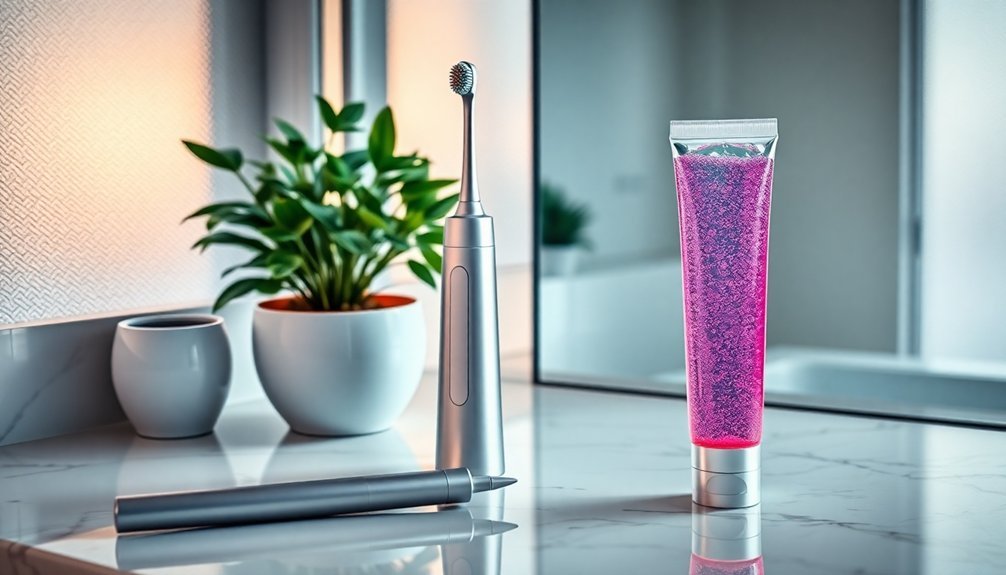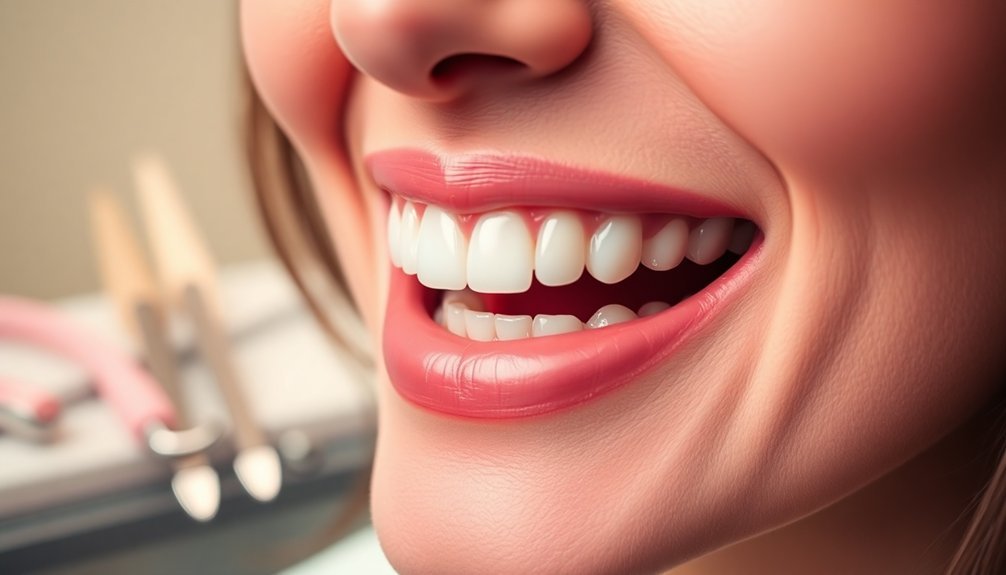To improve your gum health with near-infrared therapy, start by understanding its benefits, such as enhanced circulation and reduced inflammation. Choose a device with multiple LEDs and FDA clearance for safety. Establish a routine, aiming for sessions of 10 to 20 minutes, ideally before brushing your teeth. Don't forget to combine therapy with good oral care practices like using a soft-bristle toothbrush and flossing regularly. Finally, consult your dentist for personalized advice on treatment frequency and oral health assessments. You'll discover even more tips and insights to elevate your gum health as you explore further.
Understand Infrared Light Benefits

Understanding the benefits of infrared light can considerably enhance your gum health. Infrared therapy promotes circulation, which is essential for keeping your gums and teeth healthy. By improving blood flow, infrared light delivers vital nutrients and oxygen to oral tissues, helping them heal faster and stay resilient against infections. Regular sessions can also support your recovery after dental procedures while reducing the risk of gum disease. Additionally, enhanced circulation ensures that your gums are well-nourished and more resilient.
Moreover, infrared light has anti-inflammatory properties that help you manage conditions like gingivitis and periodontitis. By reducing inflammation, you can prevent gum recession and the tooth loss often seen with untreated dental issues. This therapy can also alleviate postoperative discomfort.
Infrared therapy aids in detoxification too. As you sweat in an infrared sauna, toxins are removed, creating a cleaner internal environment that supports your overall wellness, including oral health. The heat has antibacterial effects, further reducing harmful bacteria in your mouth, decreasing the risk of infections.
Finally, it stimulates healing and regeneration in gum tissues, enhancing cellular energy production and promoting tissue regeneration after procedures, making it an effective non-invasive method for better gum health.
Choose the Right Device
Selecting the right device for gum health can greatly impact your oral care routine. To make the best choice, look for a device equipped with multiple LEDs, specifically 12 red spectrum LEDs, 12 infrared LEDs, and 6 blue LEDs. These varying wavelengths—660nm red, 880nm infrared, and 415nm blue—work effectively to promote gum health and kill harmful bacteria. Additionally, a high-quality device contains 30 LEDs total, ensuring optimal treatment for your gums.
Ensure the device is FDA cleared for home use, confirming that it's safe and effective for treating both teeth and gums. A non-invasive design means you'll receive gentle treatment with no side effects—a major advantage over surgical procedures. Opt for a device with rechargeable batteries to enjoy cordless convenience during your sessions.
User-friendly features are essential: a one-button operation makes it easy to use, while portable and lightweight designs allow for comfortable daily application. A large treatment area covers both your upper and lower gums effectively. Finally, consider a device that's versatile enough for everyone—from families to dental professionals—allowing for daily use or supplementary treatments after dental procedures. Choosing wisely now will contribute substantially to long-term gum health.
Establish a Daily Routine

Establishing a daily routine is essential for improving gum health and reaping the benefits of red light therapy. Aim for daily sessions or at least three to five times a week for ideal results. Determine the frequency based on your individual needs and the severity of your gum issues. For those recovering from dental procedures, daily sessions might be necessary, while less frequent use can work for maintenance.
Sessions should last between 10 to 20 minutes, with consistency being key to seeing improvements. Shorter sessions of 10 to 15 minutes can be effective, especially for receding gums, while longer sessions may be beneficial for more severe conditions. This therapy not only reduces inflammation but also promotes tissue regeneration, improving overall gum health over time.
Timing matters too; consider incorporating red light therapy into your nightly routine, right before brushing and flossing. Performing sessions at the same time each day will create a habit and enhance consistency.
You may find morning sessions effective as well, but avoid using the device right before bedtime if it affects your sleep. Monitor your progress by tracking changes in inflammation and adjust your routine accordingly for the best results.
Combine With Oral Care Practices
Incorporating effective oral care practices is essential for enhancing the benefits of your daily routine, especially when it comes to maintaining healthy gums. Start by using a soft-bristle toothbrush to prevent damage during brushing. Aim to brush your teeth at least twice a day for two minutes each time. Make sure to brush gently in a circular motion, angling the bristles toward your gumline and paying special attention to cleaning under the gums.
Flossing is equally vital; try to floss at least once a day. Use floss picks or a waterpik to simplify the process, especially in those tricky spots. Wrap the floss around each tooth, hugging it to scrape along the sides and keep your gums free from plaque and bacteria.
Don't forget the impact of your diet and lifestyle. Eating a balanced diet rich in fruits, vegetables, and lean proteins supports gum health. Staying hydrated helps flush away food particles, while quitting smoking strengthens your immune system.
Consider using an antimicrobial mouthwash and a waterpik for added protection against gum disease. All these practices combined can greatly improve your gum health.
Consult Your Dental Professional

Before diving into any treatment options for gum health, it's vital to check in with your dental professional. They'll help you understand your specific gums' condition and if red light therapy is a suitable choice for you.
Here are some key points to discuss during your consultation:
- Oral Health Assessment: Your dentist will evaluate your gum recession and overall gum health to tailor a treatment plan.
- Treatment Frequency: Discuss how many sessions are needed for red light therapy and the recommended treatment frequency based on your condition.
- Procedure Insights: Gain clarity on what the therapy entails, expected outcomes, and any potential side effects.
- Costs and Insurance: Ask about costs and whether your insurance covers red light therapy or if package deals are available.
This initial consultation is important for developing a customized plan that meets your needs.
Make sure to follow up regularly, and inform your dentist of any changes in your gum health throughout the treatment process. Your proactive approach guarantees you achieve the best possible outcomes for your gum health.
Frequently Asked Questions
How Long Until I See Results With Near-Infrared Therapy?
You might notice improvements in gum sensitivity and inflammation within a few weeks of consistent use. For ideal results, use therapy daily or 3-5 times a week, with sessions lasting 10-20 minutes each.
Is Red Light Therapy Safe for Children and Pets?
Yes, red light therapy's generally safe for children and pets when used under supervision. Always choose FDA-approved devices, monitor for irritation, and guarantee proper eye protection. Consult a healthcare or veterinary professional before starting treatment.
Can I Use Red Light Therapy if I Have Braces?
Yes, you can use red light therapy with braces. It helps reduce pain, speeds up tooth movement, and enhances healing. Just remember to follow safety guidelines and consult your orthodontist for personalized advice.
Are There Any Contraindications for Using Red Light Therapy?
Yes, there are contraindications for using red light therapy. You should avoid it if you have recent burns, malignant cancers, hyperthyroidism, or are pregnant. Always consult a doctor to ascertain safety regarding your specific situation.
Can I Perform Red Light Therapy After Dental Surgery?
Yes, you can perform red light therapy after dental surgery. It accelerates healing, reduces inflammation, and alleviates pain. Just be sure to consult your dentist for guidance on proper usage and frequency.
In Summary
By incorporating near-infrared light therapy into your oral care routine, you can greatly enhance your gum health. Remember to choose the right device and create a consistent daily practice. Pair this technology with your regular oral hygiene efforts for even better results. And don't forget to consult your dental professional for personalized advice. With these powerful tips, you're well on your way to healthier gums and a brighter smile!





Leave a Reply